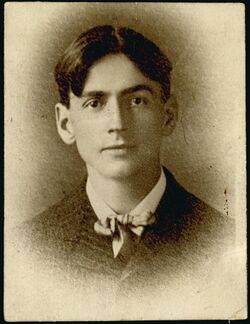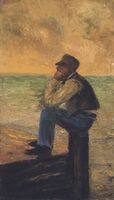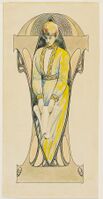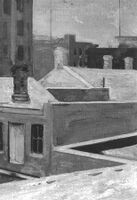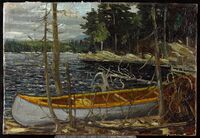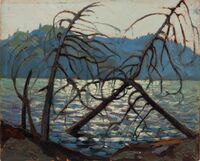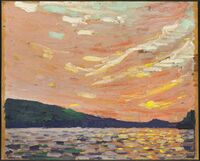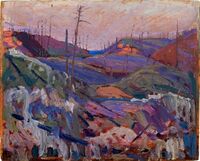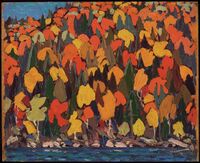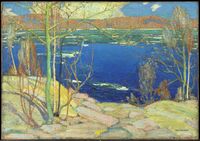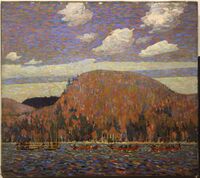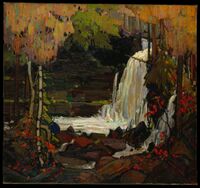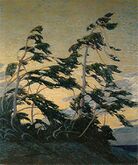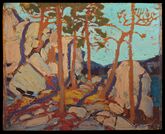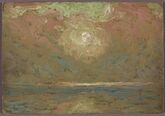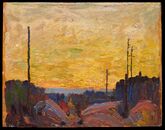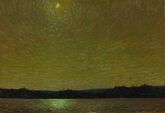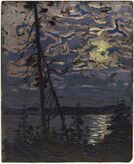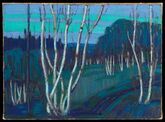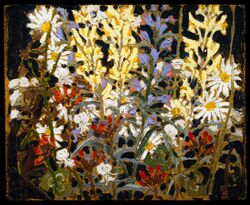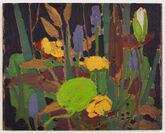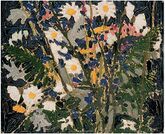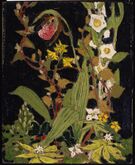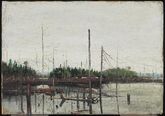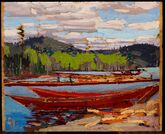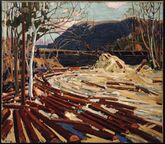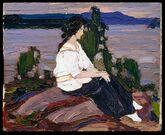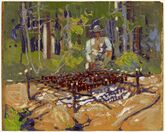Biography:Tom Thomson
Tom Thomson | |
|---|---|
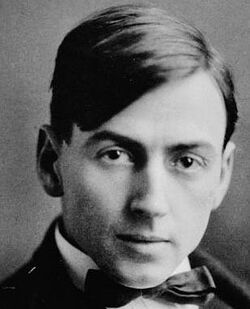 Thomson, c. 1910–1917 | |
| Born | Thomas John Thomson August 5, 1877 Claremont, Ontario, Canada |
| Died | July 8, 1917 (aged 39) Canoe Lake, Algonquin Park, Ontario, Canada |
| Resting place | Leith United Church Cemetery, Grey County, Ontario, Canada [ ⚑ ] 44°37′N 80°53′W / 44.62°N 80.88°W |
| Nationality | Canadian |
| Education | Self-taught[note 1] |
| Known for | Painting |
Notable work |
|
| Movement |
|
Thomas John Thomson (August 5, 1877 – July 8, 1917) was a Canadian artist of the early 20th century. Over the course of his short career, he produced roughly 400 oil sketches on small wood panels along with around fifty larger works on canvas. They consist almost entirely of landscapes, depicting trees, skies, lakes, rivers and other nature scenes. His painting utilizes broad brush strokes and a liberal application of paint to capture the stark beauty and vibrant colour of the Ontario landscape. Thomson's accidental death at 39 by drowning came just prior to the founding of the Group of Seven and was seen by his contemporaries as a tragedy of Canadian art.
Raised in rural Ontario, Thomson was born into a large family of farmers and did not display any immediate artistic talent. He worked several jobs through family connections before attending a business college, eventually developing rudimentary penmanship abilities. At the turn of the 20th century, he worked in Seattle and Toronto as a pen artist at several different photoengraving firms, including Grip Ltd.. There, he met those who would eventually form the Group of Seven, including J. E. H. MacDonald, Lawren Harris, Frederick Varley, Franklin Carmichael and Arthur Lismer. In May 1912, Thomson visited Algonquin Park for the first time. It was there that he acquired his first sketching equipment and, following the advice of MacDonald, began to capture nature scenes. He became enraptured with the area and would consistently return, typically spending his winters in Toronto and the rest of the year in the Park. While his earliest paintings were not outstanding technically, they illustrated an above average ability regarding composition and colour handling. Through his development his later paintings vary in composition and have vivid colours and thickly applied paint. Thomson's later work has had a great influence on Canadian art—paintings such as The Jack Pine and The West Wind have taken a prominent place in the culture of Canada and are some of the country's most iconic pieces of art.
Thomson developed a reputation during his lifetime as a veritable outdoorsman, talented in both fishing and canoeing, though his talents in the latter have been contested. The tragic circumstances of Thomson's drowning on Canoe Lake in Algonquin Park linked with his image as a master canoeist has resulted in his death entering into the popular imagination. The circumstances surrounding his death have been of particular interest to many, with unsubstantiated rumours that he was murdered or committed suicide becoming common and persisting in the years since his death.
Though he died before the formal establishment of the Group of Seven, Thomson is often considered an unofficial member with his art typically being exhibited with the rest of the Group's. Nearly all of Thomson's work is located in Canada, mainly at the Art Gallery of Ontario in Toronto, the National Gallery of Canada in Ottawa, the McMichael Canadian Art Collection in Kleinburg and the Tom Thomson Art Gallery in Owen Sound.
Life
Early years
Thomas John "Tom" Thomson was born on August 5, 1877 in Claremont, Ontario, Canada . He grew up in a large family, the sixth of John and Margaret Thomson's ten children.[6] Thomson was raised in Leith, Ontario, near Owen Sound, in the Municipality of Meaford.[7] Thomson and his siblings enjoyed both drawing and painting, though he did not immediately display any major talents.[6] He was eventually taken out of school for a year due to ill health, sometimes said to a respiratory issue variously described as "weak lungs" or "inflammatory rheumatism."[7][8][9] This gave him free time to explore the woods near his home and develop an appreciation for nature.[6] The Thomson family were unsuccessful as farmers, with Thomson and his father often abandoning their chores to instead go hiking, hunting and fishing.[10] Thomson would also regularly go on walks with Dr. William Brodie (1831–1909), his grandmother's first cousin (though the Thomson family referred to him simply as "uncle").[11][12] Brodie was a well known entomologist, ornithologist and botanist, and Thomson's sister Margaret would later recount that they collected specimens on long walks together.[13][14][note 3] Thomson was also enthusiastic about sports, breaking his toe at one point while playing football.[7] He was an excellent swimmer and fisherman, developing his passion for the latter from his grandfather and father.[8] Like most of those in his community, he regularly attended church. Some stories say that he would sketch in the hymn books during services and would entertain his sisters with caricatures of their neighbours. His sisters would later say that they had fun "guessing who they were," indicating that he was not necessarily adept at capturing people's likeness.[7]
All of Thomson's nine siblings received an inheritance from their paternal grandfather.[8] Thomson would receive his in 1898 getting $2000 in total, though he seems to have spent it all relatively quickly.[7] A year later, he entered a machine shop apprenticeship at an iron foundry owned by William Kennedy, a close friend of his father, but left only eight months later.[18][19] Also in 1899, he volunteered to fight in the Second Boer War, but was turned down because of a medical condition.[20] He would attempt to enlist for the Boer War three times total, but was denied each time.[7]
In 1901, Thomson enrolled at Canada Business College in Chatham, Ontario. The school advertised instruction in stenography, bookkeeping, business correspondence and "plain and ornamental penmanship."[8] There, he developed rudimentary penmanship abilities.[21] After graduating at the end of 1901, he would travel briefly to Winnipeg before leaving for Seattle in January 1902, joining his older brother, George Thomson.[8][21][22] George and cousin F. R. McLaren had established the Acme Business School in Seattle, listed as being the eleventh largest business school in the United States.[8][23] Thomson worked briefly as an elevator operator at the Diller Hotel. By 1902, two more of Thomson's brothers, Ralph and Henry, had moved west to join the family's new school.[19]
Graphic design work
Seattle (1901–04)
After studying at the business school for six months total, Thomson was hired at Maring & Ladd as a pen artist, draftsman and etcher.[8][21][24] He mainly produced business cards, brochures and posters, as well as three colour printing.[21][24] Having previously learned calligraphy, he specialized in lettering, drawing and painting.[24] Thomson was known to be stubborn while working at Maring and Ladd, with his brother Fraser Thomson writing that instead "of his doing the work according to the instructions given by Mr. Maring he would invariably work out the design to suit his own ideas which would make Mr. Maring angry..."[25] Thomson may have also worked as a freelance commercial designer, but there are no extant examples of such work to confirm these suspicions.[26]
He eventually moved on to a local engraving company. Despite the fact that he was being paid well, he left by the end of 1904, quickly returning to Leith. Thomson's quick move was possibly due to a rejected marriage proposal following his brief summer romance with Alice Elinor Lambert.[27][24] Lambert never married and later became a writer. In one of her stories, she describes a young girl who refused a proposal from an artist and went on to regret her decision.[7][24]
Toronto (1905–12)
Thomson moved to Toronto in the summer of 1905.[28] His first job upon his return was at the photo-engraving firm Legg Brothers, earning $11 a week.[27][29] He spent his free time reading poetry, as well as going to concerts, the theatre and sporting events.[30] In a letter to an aunt, he would write, "I love poetry best."[31] Friends described him during this time as "periodically erratic and sensitive, with fits of unreasonable despondency."[29]
Around this period, he may have briefly studied with William Cruikshank, a British artist who taught at the Ontario College of Art (today the Ontario College of Art and Design).[1] Cruikshank was likely Thomson's only art instructor.[3]
In 1908 or 1909, Thomson joined Grip Ltd., an artistic design firm in Toronto specializing in design and lettering work.[3][8][21][note 4] Grip was the leading graphic design company in the country and would introduce Art Nouveau, metal engraving and the four-colour process to Canada.[36] Albert Robson, then the art director at Grip, recalled that when he first hired Thomson, "his samples consisted mostly of lettering and decorative designs applied to booklet covers and some labels."[32][37] He would write as well that Thomson made friends slowly, though he eventually found similar interests to his coworkers.[38] Several of the employees at Grip had previously been a part of the Toronto Art Student's League, a group of newspaper artists, illustrators and commercial artists which ran from 1886 through 1904.[39] The members of the group would sketch in parts of eastern Canada and would publish an annual calendar with illustrations depicting themes of Canadian history and rural life.[40]
The senior artist at Grip, J. E. H. MacDonald, encouraged his staff to paint outside in their spare time to better hone their skills.[41][42] In December 1910, artist William Smithson Broadhead was hired, soon joined by Arthur Lismer in February 1911.[43] Robson would eventually hire Frederick Varley, followed by Franklin Carmichael in April 1911.[34][44] Though Thomson was not himself a member,[45][46] it was at The Arts and Letters Club that MacDonald would introduce Thomson to Lawren Harris.[44] The club was considered the "centre of living culture in Toronto," providing an informal environment for the artistic community.[47] Every member of what would come to be the original Group of Seven had now met.[3] MacDonald would leave Grip in November 1911 to do freelance work and spend more time painting,[48] likely the result of the Ontario Government purchasing his canvas By the River (Early Spring).[49][50]
Painting career
Exploring Algonquin Park (1912–13)
Thomson learned of Algonquin Park after hearing about it from fellow artist Tom McLean.[51][52] He would first visit the Park in May 1912, venturing through the area on a canoe trip with his Grip colleague H. B. (Ben) Jackson.[53] Together, they took the Grand Trunk Railway from Toronto to Scotia Junction, then transferred to the Ottawa, Arnprior and Parry Sound Railway, arriving at Canoe Lake Station.[52] McLean introduced Thomson to the Park superintendent, G. W. Barlett, and later met ranger Harry (Bud) Callighen while the two camped nearby on Smoke Lake.[54][55][56] It was also at this time that, according to Jackson, Thomson acquired his first sketching equipment.[51] Thomson did not yet take painting seriously however, with Jackson saying that Thomson did not think painting "would ever be taken seriously; in fact, he used to chuckle over the idea." Instead, they would spend most of their time fishing,[57] except for "a few notes, skylines and colour effects."[51][58]
During the same trip, Thomson began to read Izaak Walton's 1653 fishing guide, The Compleat Angler.[59] Beyond being a fisherman's bible, the book provided a philosophy of how to live, similar to the one illustrated in Henry David Thoreau's 1854 book, Walden, or Life in the Woods, a reflection upon simple living in natural surroundings.[60] Thomson's time in Algonquin park provided him an ideal setting to imitate Walton's "contemplative" life.[61] Ben Jackson would write of Thomson's character:
Tom was never understood by lots of people, was very quiet, modest and, as a friend of mine spoke of him, a gentle soul. He cared nothing for social life, but with one or two companions on a sketching and fishing trip with his pipe and Hudson Bay tobacco going, he was a delightful companion. If a party or the boys got a little loud or rough Tom would get his sketching kit and wander off alone. At time he liked to be that way, wanted to be by himself commune with nature.[59][61]
Once back in Toronto, Jackson would publish an article about his and Thomson's experience in the Park in the Toronto Sunday World, included in which were several illustrations.[51][62] After this initial experience, Thomson and another colleague, William Broadhead, went on a two month expedition, going up the Spanish River and into Mississagi Forest Reserve (today Mississagi Provincial Park).[61] Thomson's transition from commercial art towards his original style of painting began to be apparent around this time.[63][64] Much of his artwork from this trip, mainly oil sketches and photographs, has been lost due to two canoe spills experienced during the trip,[63] the first spill being on Green Lake in a rain squall and the second in a series of rapids.[65][note 5]
In fall 1912, Robson moved to the design firm Rous & Mann.[3] A month after returning to Toronto, Thomson left Grip to join Rous & Mann,[68] following Robson.[41][69] They would soon to be joined by Varley, Carmichael and Lismer.[65] Robson would later speak favourably of Thomson's loyalty, calling him, "a most diligent, reliable and capable craftsman."[32] Robson's success in attracting great talent was well understood.[70] Employee Leonard Rossell believed that the key to Robson's success "was that the artists felt that he was interested in them personally and did all he could to further their progress. Those who worked there were all allowed time off to pursue their studies... Tom Thomson, so far as a I know, never took definite lessons from anyone, yet he progressed quicker than any of us. But what he did was probably of more advantage to him. He took several months off in the summer and spent them in Algonquin Park."[37]
In October, Thomson was introduced to Dr. James MacCallum in MacDonald's studio.[65][71] MacCallum was a frequent visitor of the Ontario Society of Artists's (OSA) exhibitions and was admitted to the Arts and Letters Club in January 1912. It was there where he would meet artists such as John William Beatty, Arthur Heming, MacDonald and Harris.[65] MacCallum would eventually persuade Thomson to leave Rous and Mann and start a painting career.[68] In October 1913, MacCallum introduced Thomson to A. Y. Jackson, another eventual member of the Group of Seven.[72]
MacCallum recognized Thomson and Jackson's talents and offered to cover their expenses for one year if they committed themselves to painting full time.[73][74] MacCallum and Jackson both encouraged Thomson to "take up painting seriously, [but] he showed no enthusiasm. The chances of earning a livelihood by it did not appear to him promising. He was sensitive and independent, and feared he might become an object of patronage."[75] MacCallum wrote that when he first saw Thomson's sketches, he recognized their "truthfulness, their feeling and their sympathy with the grim fascinating northland... they made me feel that the North had gripped Thomson as it had gripped me since I was eleven when I first sailed and paddled through its silent places." He would further write that Thomson's paintings were "dark, muddy in colour, tight and not wanting in technical defects."[76] After Thomson's death, MacCallum would work to preserve and advocate for Thomson's work.[74]
Thomson accepted MacCallum's offer under the same terms offered to Jackson and decided to leave commercial art for the year.[72] Thomson traveled around Ontario with his colleagues, especially to the wilderness of Ontario, which was to be a major source of inspiration for him. Regarding Algonquin Park, he would write in a letter to MacCallum that, "The best I can do does not do the place much justice in the way of beauty."[77] He ventured to rural areas near Toronto and attempted to capture the surrounding nature. Thomson may have worked as a fire ranger on the Mattagami reserve.[78] Addison and Little have suggested that he guided fishing tours.[79][80] Hill has found this unlikely since Thomson had only been in the park for a few weeks in the previous year.[81] He became as familiar with logging scenes as with nature in the park and painted them both.[82]
While returning to Toronto in November 1912, Thomson stopped in Huntsville.[81][83] The visit was possibly to meet with Winfred Trainor, a woman whose family owned a cottage on Canoe Lake in Algonquin Park. Trainor was later rumoured to have been engaged to Thomson for a marriage in the fall of 1917, though there is little information available regarding their relationship.[84][note 6]
Thomson first exhibited with the OSA in March 1913, selling his painting Northern Lake (1912–13) to the Ontario Government for $250 (equivalent to CAD$5,600 in 2018) during the exhibition.[85][86] The sale afforded him time to paint and spend his time sketching through the summer and fall of 1913.[87]
Early recognition (1914–15)
Thomson often experienced self-doubt, with A. Y. Jackson recalling that in the fall of 1914, Thomson threw his sketch box into the woods out of frustration,[88][89] and was "so shy he could hardly be induced to show his sketches."[90] Often, if someone praised one of his sketches, he would immediately give it them as a gift.[45] A turning point in Thomson's career came in 1914, when the National Gallery of Canada under the directorship of Eric Brown began acquiring his paintings. Though the money he made from the sales was not enough for him to live on, the recognition it provided him was unheard of for an unknown artist such as himself.[91]
For several years he shared a studio and living quarters with fellow artists, initially living in the Studio Building with Jackson in January 1914. Jackson described the Studio Building as "a lively centre for new ideas, experiments, discussions, plans for the future and visions of an art inspired by the Canadian countryside."[92] It was there that "Thomson, after much self-deprecation, finally submitted to becoming a full-time artist."[93] They split the rent—$22 a month (equivalent to CAD$490 in 2018)—on the ground floor while construction on the rest of the building was finished.[30] After Jackson moved out in December to go to Montreal , Carmichael took his place.[30][94][95] They would share a studio space through the winter.[96][97] On March 3, 1914, Thomson was nominated to be a member of OSA by Lismer and T. G. Greene. He was elected fully on the 17th.[98] He did not participate in any of their activities however, beyond sending paintings for annual exhibitions.[45] Thomson had strange working hours, with Harris describing them years later:
In late April 1914, Thomson arrived in Algonquin Park, soon joined by Lismer who arrived on May 9. Together, they camped on Molly's Island in Smoke Lake, travelling to several different lakes, including Canoe, Smoke, Ragged, Crown and Wolf Lake.[99] Thomson spent his spring and summer divided between Georgian Bay and Algonquin Park, visiting James MacCallum by canoe. His travels during this time have proved difficult to discern, with such a great amount of ground covered in such a short time, painting the French River, Byng Inlet, Parry Sound and Go-Home Bay from May 24 through August 10.[100] H. A. Callighen, a park ranger, wrote in his journal that Thomson and Lismer left Algonquin Park on May 24.[101] By May 30, Thomson was at Parry Sound and on June 1 he was camping at the French River with MacCallum.[101][102]
Art historian Joan Murray notes that Thomson would be at Go-Home Bay for the next two months, or at least until August 10 when he is seen in Algonquin Park again by Callighan.[103] Wadland has expressed that if this timeline is correct, it would require "an extraordinary canoeist [...] especially on the open water of Georgian Bay, from the mouth of the French to Go-Home Bay (and back again). The difficulty is augmented by the fact of stopping to sketch at intervals along the way."[102] Wadland has suggested that Thomson may have traveled via train at some points, with a station connecting Algonquin Park and Parry Sound, boarding a steamship thereafter.[100] Addison and Harwood would instead say, "In the summer of 1914 Thomson paid a visit to Georgian Bay where Dr. MacCallum had a summer home. He traveled to Lake Nipissing via South River by lake, stream and portage, crossed the lake and paddled down the French River. Although he did a number of sketches at this time, he found much of the country inland monotonously flat and the rapids ordinary. In August he returned to Algonquin Park."[104] Wadland has found this characterization unhelpful, pointing out that the rapids Thomson would have faced were hardly "ordinary."[102] Jim & Sue Waddington described his route as taking him down the Magnetawan River near Algonquin Park, into Georgian Bay near Britt and then south.[105]
MacCallum provided specific dates for two of Thomson's paintings— May 30 and June 1 for Parry Sound Harbour and Spring, French River, respectively.[101][106] These are some of the only instances of precise dating for Thomson's work.[107] In addition, Cottage on a Rocky Shore is a depiction of MacCallum's cottage contrasted with the vast expanse of sky and water. Evening, Pine Island is of a nearby island MacCallum took Thomson to visit.[108] MacCallum would write, "I had planned to take him up to the North West Wooded Pine where there is a tree that had always inspired me. [...] [W]e were late in getting started, so that instead I had to take him to the South West Wooded Pine—an island of granite about a quarter of a mile in length by 100 yards wide and say 50 feet high."[108][109] Thomson continued to paint around the islands until he departed, likely because he found MacCallum's cottage too demanding socially, writing to Varley that it was "too much like north Rosedale."[108][110][111]
Thomson continued canoeing alone until he met with A. Y. Jackson at Canoe Lake in mid-September. Though World War I had erupted that year, Thomson and Jackson went on a canoe trip, in October meeting up with Varley and his wife Maud, as well as Lismer and his wife and daughter, Esther and Marjorie.[108] This marked the first time three Group of Seven members painted together, and the only time they worked with Thomson.[64][91] In his 1958 autobiography, A Painter's Country, A. Y. Jackson would write that, "Had it not been for the war, the Group [of Seven] would have formed several years earlier and it would have included Thomson."[112] Why Thomson did not serve in the war is a matter of debate.[113] Robinson and Thomson's family would say that he was turned down after multiple attempts to enlist in the army, likely due to his poor health and age but also possibly because he had flat feet.[7][114][91] Blodwen Davies wrote that Thomson's artist friends tried to convince him to not risk his life, but he decided to secretly volunteer anyway.[115] Andrew Hunter has found this scenario to be unlikely, especially given that other artist friends did volunteer for the war, such as A. Y. Jackson.[113] Thomson's sister suggested that he was a pacifist and that "he hated war and said simply in 1914 that he never would kill anyone but would like to help in a hospital, if accepted."[116] William Colgate wrote that Thomson "brooded much upon" the war and that "he himself did not enlist. Rumour has it that he tried, and failed to pass the doctor. This is doubtful."[117] Edward Godin, a companion, said "We had many discussions on the war. As I remember it he did not think that Canada should be involved. He was very outspoken in his opposition to Government patronage. Especially in the Militia. I do not think that we would offer himself for service. I know up until that time he had not tried to enlist."[118] There is only one verifiable example of Thomson's opinion on the war, taken from a letter he wrote to J. E. H. MacDonald in 1915:
As with yourself, I can't get used to the idea of [A. Y.] Jackson being in the machine and it is rotten that in this so-called civilized age that such things can exist, but since this war has started it will have to go on until one side wins out, and of course there is no doubt which side it will be, and we will see Jackson back on the job once more.[119][120]
With MacCallum's year of financial support over, Thomson's financial future was uncertain.[95] Thomson would briefly look into putting in an application to be a park ranger, but balked after seeing that it could take months for the application to go through. Instead, he considered working in an engraving shop for a few months over the winter.[108][77] He made little effort to sell his paintings, preferring to give them away, though he brought in some money from the paintings he sold.[121] In mid-November, Thomson donated In Algonquin Park to an exhibition organized to raise money for the Canadian Patriotic Fund. It was sold to Marion Long for $50 (equivalent to CAD$1,100 in 2018).[95]
In the spring of 1915, Thomson returned to Algonquin Park earlier than he had in any previous year and had already painted twenty-eight sketches by April 22. From April through July, he spent much of his time fishing, assisting groups on several different lakes. He would spend much of his summer travelling across the province, hunting and sketching.[122] In July, he was invited to send paintings to the Nova Scotia Provincial Exhibition in September.[120][123] Because Thomson was in Algonquin Park, his friends selected three works to send—two unidentified works from 1914 and the sketch Canadian Wildflowers.[123][124] From the end of September to mid-October, Thomson spent his time at Mowat,[125] a village on the north end of Canoe Lake.[126] By November, he was at Round Lake with Tom Wattie and Dr. Robert McComb.[127][128] In late November, Thomson returned to Toronto and moved into a shack behind the Studio Building that Harris and MacCallum fixed up for him,[129][130] renting it for $1 a month (equivalent to CAD$22 in 2018).[131][note 7]
Artistic peak (1916–17)
In 1915, MacCallum commissioned MacDonald, Lismer and Thomson to paint decorative panels for his cottage on Go-Home Bay. In October of that year, MacDonald went up to take dimensions.[137] Thomson produced four panels which were probably meant to go over the windows. In April 1916, when MacDonald and Lismer went to install them, they found that MacDonald's measurements were incorrect and the panels would not fit.[138][139][note 9] In March, Thomson exhibited four canvases with the OSA: In the Northland (at that time, titled The Birches), Spring Ice, Moonlight and October (then titled The Hardwoods), all of which were painted over the winter of 1915–16. Sir Edmund Walker and Eric Brown of the National Gallery of Canada wanted to purchase In the Northland, but Montreal trustee Dr. Francis Shepherd convinced them to instead purchase Spring Ice.[135] Reception to Thomson's paintings at this time were mixed. Margaret Fairbairn of the Toronto Daily Star would write, "Mr. Tom Thomson's 'The Birches' and 'The Hardwoods' show a fondness for intense yellows and orange and strong blue, altogether a fearless use of violent colour which can scarcely be called pleasing, and yet which seems an exaggeration of a truthful feeling that time will temper."[142] A more favourable take came from artist Wyly Grier in The Christian Science Monitor:
Tom Thomson again reveals his capacity to be modern and remain individual. His early pictures—in which the quality of naivete had all the genuineness of the effort of the tyro and was not the counterfeit of it which is so much in evidence in the intensely rejuvenated works of the highly sophisticated—showed the faculty for affectionate and truthful record by a receptive eye and faithful hand; but his work today has reached higher levels of technical accomplishment. His Moonlight, Spring Ice and The Birches are among his best.[143]
In The Canadian Courier, painter Estelle Kerr would similarly speak positively, describing Thomson as "one of the most promising of Canadian painters who follows the impressionist movement and his work reveals himself to be a fine colourist, a clever technician, and a truthful interpreter of the north land in its various aspects.[144]
In 1916, Thomson left for Algonquin Park earlier than any previous year, evidenced by the large number of snow studies he produced at this time.[145] In April or early May, MacCallum, Harris and his cousin Chester Harris joined Thomson at Cauchon Lake for a canoe trip.[145][146] After MacCallum and Chester left, Harris and Thomson paddled together to Aura Lee Lake.[147][note 10] Thomson produced many sketches which varied in composition, though they all had vivid colour and were applied thickly.[146] MacCallum was present when Thomson painted his Sketch for "The Jack Pine", writing, "It may interest you to know that the deocrative pine in the foreground was blown down on Thomson just before he had finished the original sketch."[145][151][152] He would go on to add that Harris thought the tree killed Thomson, "but he sprang up and continued painting."[145][153]
In the end of May Thomson took a job as a fire ranger stationed at Achray on Grand Lake with Ed Godin. He followed the Booth Lumber Company's drive down the Petawawa River to the north end of the park.[154] Thomson painted a sign, "Out-Side-In" on wood, for Godin's cabin.[155][156][157] He found that fire ranging and painting did not mix well together,[156] writing, "[I] have done very little sketching this summer as the two jobs don't fit in... When we are travelling two go together, one for canoe and the other the pack. And there's no place for a sketch outfit when your [sic] fire ranging. We are not fired yet but I am hoping to get put off right away.[158] He likely returned to Toronto in late October or early November.[156] Over the following winter, encouragement from Harris, MacDonald and MacCallum saw Thomson move into the most productive portion of his career,[159] writing in a letter that he "got quite a lot done."[160] Despite this, he did not submit any paintings to the OSA exhibition in the spring of 1917.[136] It was during this time that he produced many of what would become his most famous works, including The Jack Pine and The West Wind.[161] Dr. MacCallum suggested that several canvas works were unfinished, including Woodland Waterfall, The Pointers and The Drive.[136][162] Barker Fairely similarly described The West Wind as being unfinished.[163] Charles Hill has written that there are no reasons to believe Woodland Waterfall was unfinished.[136] Similarly while it has sometimes been suggested that The Drive was modified after Thomson's death[164] a reproduction from 1918 displays no discernible differences.[165][166]
Thomson returned to Canoe Lake at the beginning of April, arriving early enough to paint the remaining snow and the ice breaking up on the surrounding lakes. He had little money to live but wrote that he could manage for around a year. On April 28, 1917 he received a guide's licence. Unlike previous years, he remained at Mowat with Lieutenant Crombine and his wife Daphne.[167] Thomson let Mrs. Crombie select a sketch as a gift from his spring sketches and she selected Path Behind Mowat Lodge.[168]
The Pointers, Winter 1916–17. Hart House, University of Toronto
Death
On July 8, 1917, Thomson disappeared during a canoeing trip on Canoe Lake.[169] His upturned canoe was spotted later in the afternoon, while his body was discovered in the lake eight days later.[169][170] Independent examinations of the body by a doctor and a coroner revealed that the cause of death was drowning, and in particular that it was accidental.[169][171][172] The day after the body was discovered, it was interred in Mowat Cemetery near Canoe Lake.[169][173][174][note 11] Under the direction of Thomson's older brother George, the body was exhumed two days later and re-interred in the family plot beside the Leith Presbyterian Church on July 21 in what is now the Municipality of Meaford.[173][175][176]
Art and technique
Artistic development
Thomson was largely self-taught. He was employed as a graphic designer with Toronto's Grip Ltd., an experience which honed his draughtsmanship.[3] Although he began painting and drawing at an early age, it was only in 1912, when Thomson was well into his thirties, that he began to paint seriously.[63][64] His first trips to Algonquin Park inspired him to follow the lead of fellow artists in producing oil sketches of natural scenes on small, rectangular panels for easy portability while travelling. Between 1912 and his death in 1917, Thomson produced hundreds of these small sketches, many of which are now considered works in their own right, and are housed in such galleries as the Art Gallery of Ontario in Toronto, the National Gallery of Canada in Ottawa, and the McMichael Canadian Art Collection in Kleinburg.[177]
Thomson peaked creatively between 1914 and 1917. He was aided by the patronage of Toronto physician James MacCallum, who enabled Thomson's transition from graphic designer to professional painter.[73][74] Although the Group of Seven was not founded until after Thomson's death, his work is sympathetic to that of group members A. Y. Jackson, Frederick Varley, and Arthur Lismer. These artists shared an appreciation for rugged, unkempt natural scenery, and all used broad brush strokes and a liberal application of paint to capture the stark beauty and vibrant colour of the Ontario landscape.[180][181] Thomson's art also bears some stylistic resemblance to the work of European post-impressionists such as Vincent van Gogh, whose work he may have known from books or visits to art galleries.[182] Other key influences were the Art Nouveau and Arts and Crafts movements of the late nineteenth and early twentieth centuries, styles with which he would have been familiar from his work in the graphic arts.[183]
The artwork of Thomson is typically divided into two bodies: the first is made up of the small oil sketches on wood panels, of which there are around 400, and the second is of around fifty larger works on canvas.[177] The smaller sketches were typically done in the style of en plein air in "the North," primarily Algonquin Park, in the spring, summer and fall.[184] The larger canvases were instead completed over the winter in Thomson's studio—an old utility shack with a wood-burning stove on the grounds of the Studio Building, an artist's enclave in Rosedale, Toronto.[30][185][186] A dozen or so of the major canvases were directly derived from smaller sketches. Indeed, paintings like Northern River, Spring Ice, The Jack Pine and The West Wind were only later expanded into larger oil paintings.[177] While the sketches were produced quickly, the canvases were developed over weeks or even months. Because of this, they display an "inherent formality," with the transition from small to large requiring a reinvention or elaboration of the original details.[187] Comparing sketches with their respective canvases allows one to see the changes Thomson made in colour, detail and background textural patterns.[188][189] Although Thomson sold few of the larger paintings during his lifetime, they formed the basis of posthumous exhibitions, including one at Wembley in London, that eventually brought international attention to his work.[190]
Described as having an "idiosyncratic palette," Thomson's control of colour was exceptional.[191] He often mixed available pigments to create unusual, new colours making his distinctive palette along with his brushwork instantly recognizable regardless of the subject of his work.[192] His painting style and the atmosphere, colours and forms of his work directly inspired the work of his colleagues, particularly Jackson, Lismer, MacDonald and Harris.[193] Mark Robinson would later recount that Thomson usually had a particular motif he wanted to depict before going into nature to find a comparison.[194][195][196]
Series and themes
Trees
Thomson's most famous paintings are his depictions of pine trees, particularly The Jack Pine and The West Wind. David Silcox has described these paintings as, "the visual equivalent of a national anthem, for they have come to represent the spirit of the whole country, notwithstanding the fact that vast tracts of Canada have no pine trees,"[197] and, "so majestic and memorable that nearly everyone knows them."[198] Arthur Lismer would describe things similarly, saying that the tree in The West Wind was a symbol of the Canadian character, unyielding to the wind and emblematic of steadfastness and resolution.[199][200]
Thomson had a great enthusiasm for trees and worked to capture their forms, the effect of the seasons upon them and the surrounding context of their location. He normally depicted trees as amalgamated masses, giving them "form structure and colour by dragging paint in bold strokes over an underlying tone."[201] His favourite motif was of a slight hill next to a body of water.[202] The enthusiasm he had is especially apparent in an anecdote from Ernest Freure, who invited Thomson to camp on an island on Georgian Bay with him:[203]
One day while we were together on my island, I was talking to Tom about my plans for cleaning up the dead wood and trees and I said I was going to cut down all the trees but he said, "No, don't do that, they are beautiful."[204]
The theme of the single tree is a common one in Art Nouveau, though Thomson may also have been heavily influenced by the work of MacDonald while working at Grip Limited. MacDonald was likely influenced by the landscape art of John Constable, whose work he would have seen while in England from 1903 to 1906.[205] Thomson's earlier paintings were closer to literal renderings of the trees in front of him, while as he progressed they became more expressive with individual characteristics amplified.[206] The painting Byng Inlet, Georgian Bay is an example of the broken, high-keyed colour Thomson and his colleagues were experimenting with during that time, and is similar to Lismer's Sunglow. While Lismer only applied the technique to the water, Thomson applied it over the entire composition.[207]
According to MacCallum, the painting Pine Island, Georgian Bay was worked on over an extended period.[207] He would write specifically that this painting had "more emotion and feeling than any other of [Thomson's] canvases."[207][208] In contrast, MacDonald found it "rather commonplace in color & composition & not representative of Thomson at his best."[209][210]
Skies
Thomson was preoccupied with capturing the sky, especially near the end of his career from 1915 onward. Paintings like Sunset—which was painted at water level in a canoe—illustrate his excited brushstrokes in capturing the lakes reflection.[211] The painting was done over a grey-green ground, adding depth to both the light on the sky and the reflecting water.[133] Paintings from 1913 and on consistently utilize the perspective of the canoe, with a narrow foreground of water, a distant shoreline and a dominating sky.[179][212]
The 1915 volcanic eruption of Lassen Peak in California provided dramatic sunrises and sunsets in the northern hemisphere for the year. These skies provided artistic inspiration for Thomson and other artists in the same way that the eruption of Krakatoa in the previous century had inspired painter Edvard Munch.[212][213] Sky effects would be one of Thomson's main interests for the entire year, indicated by his heightened use of colour.[133]
Harold Town has compared Sky (The Light That Never Was) to the works of J. M. W. Turner. In particular, he notes the way that the sky "[creeps] into the landscape, big rhythms supplanting small movement." The horizon disappears and pure movement is left behind.[214]
Nocturnes
Thomson produced more nocturnes than the rest of the Group of Seven combined—roughly two dozen.[215][216] MacCallum would recall that Thomson would often spend his nights laying in his canoe in the middle of the lake, stargazing and avoiding mosquitoes.[215][217] Besides capturing the nighttime sky, he also captured silhouettes of spruce and birch trees, lumber camps, two moose emerging from water and the northern lights, painting five different sketches of the aurora.[216][218] Park ranger Mark Robinson would later recount that Thomson would stand and contemplate the aurora for an extended period of time before going back into a cabin, painting by lamplight.[219] Given the difficulty of painting by only moonlight, most if not all of Thomson's noctures were painted from memory. MacCallum confirmed this with the sketch Moose at Night, writing on the back "Winter 1916—at studio,"[167] likely implying it was painted in Toronto.[220]
Nocturne, Fall 1915. Vancouver Art Gallery, Vancouver
Flowers
As was typical for early twentieth century painting, Thomson produced still lifes of flowers. These paintings, especially Marguerites, Wood Lillies and Vetch and Wildflowers, are particularly powerful examples of the genre.[221] In these paintings, he redirected emphasis from the delicacy of the flowers towards simple broad strokes of colour, something Harold Town thought "[imparted] a toughness of design sometimes missing in his harder themes of rock and bracken."[222]
Industry in nature
During Thomson's time in Algonquin Park, logging and the lumber industry were a constant presence.[223][note 12] He often painted the machinery left behind by lumber companies, with Lismer, MacDonald and himself being especially drawn to the subject. A. Y. Jackson would write,
It was a ragged country; a lumber company had slashed it up, and fire had run through it... Thomson was much indebted to the lumber companies. They had built dams and log chutes, and had made clearings for camps. But for them, the landscape would have been just bush, difficult to travel in and with nothing to paint.[179][224][225]
Besides the dams, pointers, alligators and drives depicted in Thomson's work, other less obvious depictions of the lumber industry were depicted. For example, areas cleared out due to logging appear in early sketches, such as Canoe Lake (1913) and Red Forest. The painting Drowned Land similarly displays the damage caused by logging operations and flooding due to damming.[68] As well, the white birches present in many paintings only thrive in "sunny, open areas whose previous tree cover had been removed,"[226] meaning that logging was in some way necessary for them to flourish.[223]
Around 1916, Thomson followed the drive of logs down the Madawaska River, painting the subject in The Drive. MacDonald similarly expressed the drive in his 1915 painting Logs on the Gatineau.[227]
Thomson's and the other artist's work is absent of criticism for the typical Canadian attitudes of the time, namely that the available natural resources were meant to be exploited.[228][229] Harold Town has argued that, while Thomson and the other artists were not critical of industry, mining and logging, they did not glorify these issues and they took a relatively low profile within the art produced.[229][82]
People
Thomson, like most of the members of the Group of Seven, rarely painted people.[230][231][note 13] Harold Town would remark that both Thomson and Canadian artist David Milne "shared in common a similar inability to draw the human figure,"[233] something professor John Wadland thought was "embarrassingly evident" in several of Thomson's portraits.[68] Town would go on to describe paintings like Man with Axe (Lowery Dixon) Splitting Wood as stiff, yet still held together in a cohesive crudity. He described Figure of a Lady, Laura differently, writing that it was a tender work that is "well-designed and plainly expressed, this loving picture is so secure in intention that it survives, indeed triumphs, over the severe cracking of the paint."[232] Thomson's most successful attempts at capturing people typically feature figures far off in the distance, allowing them to blend in to the scene. This is apparent in paintings like Little Cauchon Lake, Bateaux, The Drive, The Pointers and Tea Lake Dam.[230]
Legacy and influence
Since his death, Thomson's work has grown in value and popularity. Scholar Sherrill Grace has written that Thomson is a "haunting presence" for Canadian artists and that he "embodies the Canadian artistic identity."[234] Group of Seven member Arthur Lismer would similarly write that "Tom Thomson is the manifestation of the Canadian character."[199]
In September 1917, J. E. H. MacDonald and John William Beatty erected a memorial cairn at Hayhurst Point on Canoe Lake, to honour Thomson where he died.[173][235][236] In the summer of 2004 another historical marker honouring Thomson was moved from its previous location nearer the centre of Leith to the graveyard in which Thomson is now buried.[237] In 1967, the Tom Thomson Art Gallery opened in Owen Sound.[238] Many of his works are also on display at the National Gallery of Canada in Ottawa, the Art Gallery of Ontario, and the McMichael Canadian Art Collection in Kleinburg, Ontario. Thomson's influence can be seen in the work of later Canadian artists, including Emily Carr, Goodridge Roberts, Harold Town, and Joyce Wieland.[239]
The outdoorsman
Though he is most known for his painting, Thomson is often mythologized as a veritable outdoorsman.[240] Dr. James MacCallum would contribute stories to this image.[240] Thomson has often been remembered as an expert canoeist, though David Silcox has argued that this image is likely romanticized.[241] In the case of fishing however, Thomson was no doubt proficient. He had a deep love of fishing for his entire life, so much so that his reputation through Algonquin Park was equally divided between art and angling.[242] While most who visited the Park were led by hired guides, Thomson moved through on his own. Indeed, many of his fishing locations appear in his work.[243]
Death conspiracy theories
Many conspiracy theories have swirled around the nature of Tom Thomson's death, including that he was murdered or committed suicide. Though these ideas lack substantiation, they have continued to persist in the popular culture.[169][244] Andrew Hunter has pointed to Robinson as being largely responsible for the suggestion that there was more to Thomson's death than accidental drowning. Hunter expands on this thought, writing, "...I am convinced that people's desire to believe the Thomson murder mystery/soap opera is rooted in the firmly fixed idea that he was an expert woodsman, intimate with nature. Such figures aren't supposed to die by "accident." If they do, it is like Grey Owl's being exposed as an Englishman."[245]
References
Footnotes
- ↑ Thomson may have briefly studied under British artist William Cruikshank around 1905.[1] It is also possible that he read John Ruskin's 1857 handbook, The Elements of Drawing, while learning to draw.[2] Besides these instances though, it is clear that he had no other art instruction.[3] For more regarding the public's perception of Thomson's instruction, refer to Death and legacy of Tom Thomson § An "untainted" artist.
- ↑ Though he died before the Group of Seven's founding in 1920, Thomson's connection to the artists and the art they created is unquestionable.[4] In his 1964 book, The Story of the Group of Seven, Lawren Harris would write, I have, in my story of the Group, included Tom Thomson as a working member, although the name of the group did not originate until after his death. Tom Thomson was, nevertheless, as vital to the movement, as much a part of its formation and development, as any other member.[5]
- ↑ William Brodie was a member of the Royal Canadian Institute, curator of the Ontario Provincial Museum and provincial entomologist from 1903 until his death in 1909.[15] The Dictionary of Canadian Biography would report that, "By 1900 Brodie's biological collections ranked among the finest on the continent, and contained 100,000 specimens of Ontario flora and fauna. [...] He rejected the traditional emphasis on morphology in favour of a greater focus on ecology, the relation of living things to their environment."[16] He was also known to have been a mentor to naturalist Ernest Thompson Seton.[17]
- ↑ Sources disagree on the approximate time of Thomson being hired. Grip supervisor Albert H. Robson wrote in 1932 that he was hired in 1907,[32] but by 1937 Robson was instead writing that he was hired in 1908.[33] Robert Stacey has suggested December 1908.[21] David Silcox has suggested the beginning of 1909.[3] Art historian Joan Murray has suggested December 1908 or January 1909.[34] In curator Charles Hill's investigation, he noted that Thomson is listed in the Toronto City Directory for 1906–09 as working with Legg Bros. Photo Engravers, in 1910 merely as an artist living at 99 Gerrard E., and in 1911 as being at Grip Ltd. Hill supposes that this means Thomson likely began at Grip in late 1909, after the information for the 1910 directory was collected.[35]
- ↑ Thomson would write in a letter to his friend M. J. (John) McRuer: We started in at Bisco and took a long trip on the lakes around there going up the Spanish River and over into the Mississauga [Mississagi] water we got a great many good snapshots of game—mostly moose and some sketches, but we had a dump in the forty-mile rapids which is near the end of our trip and lost most of our stuff—we only saved 2 rolls of film out of about 14 dozen. Outside of that we had a peach of a time as the Mississauga is considered the finest canoe trip in the world.[66][67]
- ↑ For more regarding Thomson's possible romantic relationship with Trainor, refer to MacGregor (2010).
- ↑ In his 1959 piece, "My Memories of Tom Thomson," Thoreau MacDonald (son of J. E. H. MacDonald) cited November 1915 as when Thomson moved into the shack behind the Studio Building.[132] Most sources agree with this, including Charles Hill,[133] William Little[130] and Addison & Harwood.[129] David Silcox has written that the move happened in either late 1914[30] or early 1915.[30][134]
- ↑ In the Northland was originally titled The Birches.[135] All of Thomson's canvases from the winter of 1916–17 were titled after his death.[136]
- ↑ MacDonald's measurements were 44½ × 37", but the panels installed were 27 × 37". The panels Thomson produced were 47½ × 38".[140][141]
- ↑ Upon Harris' return to Toronto he would enlist in the army. He received his Canadian Officers' Training Corps certificate on May 5 and was appointed lieutenant to the 10th Royal Grenadiers on June 12.[147][148] He initially taught musketry at Camp Borden.[149] In May 1918 he was discharged after suffering a nervous breakdown.[149][150]
- ↑ Mowat Cemetery was located at [ ⚑ ] 45°33′47″N 78°43′42″W / 45.56306°N 78.72833°W.
- ↑ For more regarding the industrialization of Algonquin Park, refer to:
- ↑ Notable exceptions to this are Frederick Varley and Frank Johnston, with Varley's main interest being people, faces and figures.[231][232] At the beginning of his career, Lawren Harris captured people in nearly all of his depictions of Toronto and did several portraits, but later moved on to only depicting landscapes. Edwin Holgate painted the female figure and completed several nudes.[231]
Citations
- ↑ 1.0 1.1
- Murray (1986), p. 6
- Reid (2002a), pp. 52, 70, 113, 309, 324n21, 329n18
- Silcox & Town (1977), p. 235
- Silcox (2015), pp. 9, 100
- Silcox & Town (2017), p. 43
- ↑ Murray (1999), p. 2.
- ↑ 3.0 3.1 3.2 3.3 3.4 3.5 3.6 Silcox (2015), p. 9.
- ↑ Waddington & Waddington (2016), p. 29.
- ↑ Harris (1964), p. 7.
- ↑ 6.0 6.1 6.2 Silcox (2015), p. 4.
- ↑ 7.0 7.1 7.2 7.3 7.4 7.5 7.6 7.7 Silcox & Town (2017), p. 41.
- ↑ 8.0 8.1 8.2 8.3 8.4 8.5 8.6 8.7 Hill (2002), p. 113.
- ↑ MacDonald (1917), p. 47.
- ↑ Murray (1998), pp. 14–15, 22–25.
- ↑ Silcox (2015), p. 57.
- ↑ Murray (1999), p. 5.
- ↑ Murray (1999), pp. 6–7.
- ↑ Wadland (2002), p. 93.
- ↑ Murray (1998), pp. 15–17, 43, 45, 49, 56, 87.
- ↑ Zeller (1994), pp. 112–14.
- ↑ Wadland (1978).
- ↑ Reid (2002a), pp. 50, 86, 113.
- ↑ 19.0 19.1 Silcox (2015), p. 6.
- ↑ Silcox (2006), pp. 107–108.
- ↑ 21.0 21.1 21.2 21.3 21.4 21.5 Stacey (2002), p. 50.
- ↑ Silcox & Town (2017), p. 42.
- ↑ Murray (1971), p. 9.
- ↑ 24.0 24.1 24.2 24.3 24.4 Silcox (2015), p. 7.
- ↑ Thomson (1930).
- ↑ Stacey (2002), p. 51.
- ↑ 27.0 27.1 Stacey (2002), p. 52.
- ↑ Wadland (2002), p. 92.
- ↑ 29.0 29.1 Silcox (2015), p. 7.
- ↑ 30.0 30.1 30.2 30.3 30.4 30.5 Silcox (2006), p. 127.
- ↑ Murray (1999), p. viii.
- ↑ 32.0 32.1 32.2 Robson (1932), p. 138.
- ↑ Robson (1937), p. 5.
- ↑ 34.0 34.1 Murray (2002b), p. 310.
- ↑ Hill (2002), p. 113n16.
- ↑ King (2010), p. 14.
- ↑ 37.0 37.1 Rossell (c. 1951), p. 3.
- ↑ Robson (1937), p. 6.
- ↑ Hill (2002), p. 115.
- ↑ Stacey (1998), p. 96n9.
- ↑ 41.0 41.1 Stacey (2002), p. 58.
- ↑ Rossell (c. 1951), p. 1.
- ↑ Tooby (1991).
- ↑ 44.0 44.1 Murray (2004), p. 16.
- ↑ 45.0 45.1 45.2 Hill (2002), p. 117.
- ↑ Silcox (2015), p. 9n2.
- ↑ Reid (1970), p. 28.
- ↑ Stacey & Bishop (1996), p. 118.
- ↑ Hill (2002), p. 114.
- ↑ Bayer (1981), p. 52.
- ↑ 51.0 51.1 51.2 51.3 Hill (2002), p. 118.
- ↑ 52.0 52.1 Wadland (2002), p. 94.
- ↑
- Hunter (2002), p. 25
- Klages (2016), p. 21
- Silcox (2006), p. 20
- Silcox (2015), p. 10
- Stacey (2002), p. 57
- ↑ Northway (1970), p. 6.
- ↑ Addison (1974), p. 75.
- ↑ Davies (1935), pp. 35–36.
- ↑ Hunter (2002), pp. 25–26.
- ↑ Jackson (1931b).
- ↑ 59.0 59.1 Jackson (1930).
- ↑ Hunter (2002), p. 26.
- ↑ 61.0 61.1 61.2 Hunter (2002), p. 27.
- ↑ Jackson (1912).
- ↑ 63.0 63.1 63.2 Silcox (2015), p. 10.
- ↑ 64.0 64.1 64.2 Silcox (2006), p. 23.
- ↑ 65.0 65.1 65.2 65.3 Hill (2002), p. 119.
- ↑ Thomson (1912).
- ↑ Murray (2002a), p. 297.
- ↑ 68.0 68.1 68.2 68.3 Wadland (2002), p. 95.
- ↑ Klages (2016), p. 23.
- ↑ Stacey (2002), p. 57-58.
- ↑ MacCallum (1918), p. 375.
- ↑ 72.0 72.1 Hill (2002), p. 122.
- ↑ 73.0 73.1 Silcox (2006), p. 21.
- ↑ 74.0 74.1 74.2 Silcox (2015), p. 11.
- ↑ Jackson (1933b).
- ↑ MacCallum (1918), p. 376.
- ↑ 77.0 77.1 Thomson (1914b).
- ↑ Murray (2002b), p. 312.
- ↑ Addison (1974), p. 18.
- ↑ Little (1970), p. 13.
- ↑ 81.0 81.1 Hill (2002), p. 121.
- ↑ 82.0 82.1 Silcox (2015), p. 58.
- ↑ Addison (1974), pp. 25–26.
- ↑ Silcox (2015), p. 12.
- ↑ Hill (2002), p. 120.
- ↑ Silcox (2015), p. 12.
- ↑ Stacey (2002), p. 60.
- ↑ Davies (1935), pp. 74–75.
- ↑ Jackson (1958), p. 31.
- ↑ Jackson (1917).
- ↑ 91.0 91.1 91.2 Silcox (2015), p. 13.
- ↑ Jackson (1958), p. 27.
- ↑ Jackson (1933a), p. 138.
- ↑ Murray (2006), p. 17.
- ↑ 95.0 95.1 95.2 Hill (2002), p. 128.
- ↑ Klages (2016), p. 207.
- ↑ King (2010), pp. 154–59.
- ↑ Ontario Society of Artists (1914).
- ↑ Hill (2002), p. 124.
- ↑ 100.0 100.1 Wadland (2002), p. 105.
- ↑ 101.0 101.1 101.2 Hill (2002), p. 125.
- ↑ 102.0 102.1 102.2 Wadland (2002), p. 105n70.
- ↑ Murray (2002b), p. 313.
- ↑ Addison & Harwood (1969), p. 32.
- ↑ Waddington & Waddington (2016), p. 112.
- ↑ Murray (2004), p. 108.
- ↑ Hill (2002), pp. 125–26.
- ↑ 108.0 108.1 108.2 108.3 108.4 Hill (2002), p. 126.
- ↑ MacCallum (1939).
- ↑ Thomson (1914a).
- ↑ Waddington & Waddington (2016), p. 131.
- ↑ Jackson (1958), pp. 53–54.
- ↑ 113.0 113.1 Hunter (2002), p. 40.
- ↑ Silcox (2006), pp. 107–08.
- ↑ Davies (1930a), pp. 29–31.
- ↑ Thomson (1956), pp. 21–24.
- ↑ Colgate (1946), p. 15.
- ↑ Godin (1931).
- ↑ Hunter (2002), p. 41.
- ↑ 120.0 120.1 Thomson (1915a).
- ↑ Silcox (2015), p. 14.
- ↑ Hill (2002), p. 131.
- ↑ 123.0 123.1 Hill (2002), p. 133.
- ↑ Thomson (1915b).
- ↑ Little (1955), p. 205.
- ↑ Wadland (2002), p. 102.
- ↑ Ghent (1949).
- ↑ Addison & Harwood (1969), p. 46.
- ↑ 129.0 129.1 Addison & Harwood (1969), p. 84.
- ↑ 130.0 130.1 Little (1970), p. 179.
- ↑ Silcox (2015), p. 13.
- ↑ Hill (2002), p. 132n119.
- ↑ 133.0 133.1 133.2 Hill (2002), p. 132.
- ↑ Silcox (2015), pp. 12–13.
- ↑ 135.0 135.1 Hill (2002), p. 136.
- ↑ 136.0 136.1 136.2 136.3 Hill (2002), p. 139.
- ↑ Landry (1990), p. 26.
- ↑ Reid (1970), p. 93.
- ↑ Stacey (1996), p. 119.
- ↑ Hill (2002), p. 136n134.
- ↑ Reid (1969), pp. 49, 69.
- ↑ Fairbairn (1916).
- ↑ Grier (1916).
- ↑ Kerr (1916), p. 13.
- ↑ 145.0 145.1 145.2 145.3 Hill (2002), p. 137.
- ↑ 146.0 146.1 Silcox (2015), p. 16.
- ↑ 147.0 147.1 Reid (1970), p. 126.
- ↑ Hill (2002), p. 137n145.
- ↑ 149.0 149.1 Roza (1997), p. 26n24.
- ↑ Murray (2006), p. 52.
- ↑ MacCallum (1921a).
- ↑ MacCallum (1921b).
- ↑ MacCallum (1937a).
- ↑ Hill (2002), pp. 137–38.
- ↑ Reid (2002b), p. 82.
- ↑ 156.0 156.1 156.2 Hill (2002), p. 138.
- ↑ Addison (1974), p. 126.
- ↑ Thomson (1916).
- ↑ Silcox (2006), p. 20.
- ↑ Thomson (1917b).
- ↑ Silcox (2015), p. 17.
- ↑ MacCallum (1918), pp. 375–85.
- ↑ Fairley (1920), p. 246.
- ↑ Forsey (1975), p. 188.
- ↑ Hill (2002), pp. 140, 140n167.
- ↑ MacCallum (1918), p. 380.
- ↑ 167.0 167.1 Hill (2002), p. 141.
- ↑ Little (1955), pp. 205–06.
- ↑ 169.0 169.1 169.2 169.3 169.4 Silcox & Town (2017), p. 49.
- ↑ Fraser (1917b).
- ↑ Howland (1917).
- ↑ Ranney (1931).
- ↑ 173.0 173.1 173.2 Hill (2002), p. 142.
- ↑ Robinson (1917).
- ↑ Silcox & Town (2017), p. 49–50.
- ↑ "Historic Leith Church" (in en-gb). https://www.meaford.ca/tourism/plan-trip-meaford/what-to-do/heritage-arts-culture/175-historic-leith-church.html.
- ↑ 177.0 177.1 177.2 Silcox & Town (2017), p. 181.
- ↑ Jackson (1919).
- ↑ 179.0 179.1 179.2 Silcox (2006), p. 211.
- ↑ Silcox (2015), p. 40.
- ↑ Silcox & Town (2017), p. 140.
- ↑ Silcox (2015), pp. 30, 48.
- ↑
- Hill (2002), p. 113
- Murray (1999), p. 7
- Silcox (2015), pp. 22, 47, 68, 71
- Silcox & Town (2017), pp. 94, 210
- ↑ Silcox (2015), pp. 59–60.
- ↑ Silcox & Town (2017), pp. 181–85.
- ↑ Brown (1998), pp. 151, 158.
- ↑ Silcox & Town (2017), pp. 181–82.
- ↑ Silcox & Town (2017), p. 182.
- ↑ Murray (2006), p. 92.
- ↑ Dejardin (2011).
- ↑ Silcox (2015), pp. 72–73.
- ↑ Silcox (2015), p. 73.
- ↑ Silcox (2006), p. 212.
- ↑ Hill (2002), pp. 133–34.
- ↑ Davies (1935), pp. 108–09.
- ↑ Little (1970), pp. 187–89.
- ↑ Silcox (2006), p. 50.
- ↑ Silcox & Town (2017), p. 19.
- ↑ 199.0 199.1 Lismer (1934), pp. 163–64.
- ↑ Murray (1999), p. 114.
- ↑ MacCallum (1918), pp. 379–80.
- ↑ Murray (1999), p. 8.
- ↑ Murray (1999), p. v.
- ↑ Freure (1935).
- ↑ Murray (1999), p. 7.
- ↑ Murray (1999), p. 15.
- ↑ 207.0 207.1 207.2 Hill (2002), p. 129.
- ↑ MacCallum (1938).
- ↑ Hill (2002), p. 129n106.
- ↑ MacDonald (1921).
- ↑ Silcox (2015), p. 27.
- ↑ 212.0 212.1 Silcox (2015), p. 28.
- ↑ King (2010), p. 182.
- ↑ Silcox & Town (2017), p. 58.
- ↑ 215.0 215.1 Silcox (2015), p. 38.
- ↑ 216.0 216.1 Silcox & Town (2017), p. 221.
- ↑ Silcox & Town (2017), pp. 221, 236.
- ↑ Silcox (2015), pp. 37–38.
- ↑ Little (1970), p. 198.
- ↑ Hill (2002), p. 134n127.
- ↑ Silcox (2006), p. 75.
- ↑ Silcox & Town (2017), p. 96.
- ↑ 223.0 223.1 Hunter (2002), p. 30.
- ↑ Jackson (1958).
- ↑ Sloan (2010), pp. 70–71.
- ↑ Strickland (1996), p. 19.
- ↑ Silcox (2006), pp. 211, 255–56.
- ↑ Silcox (2006), pp. 210–11.
- ↑ 229.0 229.1 Silcox & Town (2017), p. 72.
- ↑ 230.0 230.1 Hunter (2002), p. 32.
- ↑ 231.0 231.1 231.2 Silcox (2006), p. 76.
- ↑ 232.0 232.1 Silcox & Town (2017), p. 124.
- ↑ Silcox & Town (1977), p. 26.
- ↑ Grace (2004a), p. 96.
- ↑ Silcox (2006), p. 213.
- ↑ Silcox & Town (2017), p. 240.
- ↑ "Leith United Church | Heritage Meaford". http://www.heritagemeaford.com/heritage-church.php?mid=1.
- ↑ "Tom Thomson Art Gallery". City of Owen Sound. https://www.tomthomson.org/.
- ↑ Stanners (2017).
- ↑ 240.0 240.1 Silcox & Town (2017), p. 236.
- ↑ Silcox & Town (2017), p. 237.
- ↑ Hunter (2002), p. 28.
- ↑ Hunter (2002), p. 29.
- ↑ Klages (2016), pp. 274–97.
- ↑ Hunter (2002), p. 39.
Sources
Books
- Addison, Ottelyn; Harwood, Elizabeth (1969). Tom Thomson: The Algonquin Years. Toronto: Ryerson Press.
- Brown, W. Douglas (1998). "The Arts and Crafts Architecture of Eden Smith". in Latham, David. Scarlet Hunters: Pre-Raphaelitism in Canada. Toronto: Archives of Canadian Art. ISBN 978-1-89423-400-9.
- Colgate, William, ed (1946). Two Letters of Tom Thomson, 1915 and 1916. Weston: Old Rectory Press.
- Davies, Blodwen (1930a). Paddle & Palette: The Story of Tom Thomson. Toronto: Ryerson Press.
- Dejardin, Ian A. C. (2011). Painting Canada: Tom Thomson and the Group of Seven. London: Dulwich Picture Gallery. ISBN 978-0-85667-686-4.
- Edwards, Ron (1976). Petawawa River Survey Sites: A History. Algonquin Region: Ministry of Natural Resources.
- Forsey, William C. (1975). The Ontario Community Collects: A Survey of Canadian Painting from 1766 to the Present. Toronto: Art Gallery of Ontario.
- Grace, Sherril (2004a). Inventing Tom Thomson: From Biographical Fictions to Fictional Autobiographies and Reproductions. Montreal: McGill-Queen's University Press. ISBN 978-0-77352-752-2.
- Harris, Lawren S. (1964). The Story of the Group of Seven. Toronto: Rous and Mann Press.
- Hill, Charles (2002). "Tom Thomson, Painter". in Reid, Dennis. Tom Thomson. Toronto/Ottawa: Art Gallery of Ontario/National Gallery of Canada. pp. 111-143. ISBN 978-1-55365-493-3.
- Hunter, Andrew (2002). "Mapping Tom". in Reid, Dennis. Tom Thomson. Toronto/Ottawa: Art Gallery of Ontario/National Gallery of Canada. pp. 19–46. ISBN 978-1-55365-493-3.
- Arts Club of Montreal (1919). "Foreword". Catalogue of an Exhibition of Paintings by the Late Tom Thomson, March 1 to March 21, 1919.
- Davies, Blodwen (1935). "Foreword". A Study of Tom Thomson: The Story of a Man Who Looked for Beauty and for Truth in the Wilderness. Toronto: Discus Press.
- King, Ross (2010) (in en). Defiant Spirits: The Modernist Revolution of the Group of Seven. Douglas & McIntyre. ISBN 978-1-55365-807-8. https://books.google.ca/books?id=WGjfZPizNQIC&dq=9781553658078.
- Klages, Gregory (2016). The Many Deaths of Tom Thomson: Separating Fact from Fiction. Toronto: Dundurn. ISBN 978-1-45973-196-7.
- Landry, Pierre (1990). The MacCallum-Jackman Cottage Mural Paintings. Ottawa: National Gallery of Canada. ISBN 978-0-888-84598-6.
- Little, William T. (1970). The Tom Thomson Mystery. Toronto: McGraw-Hill Ryerson Ltd..
- Lloyd, Donald L. (2000). Canoeing Algonquin Park. Toronto: Donald L. Lloyd. ISBN 978-0-96865-560-3.
- MacGregor, Roy (2010). Northern Light: The Enduring Mystery of Tom Thomson and the Woman Who Loved Him. Toronto: Random House Canada. ISBN 978-0-30735-739-7.
- McKenna, Ed (1976). A Systematic Approach to the History of the Forest Industry in Algonquin Park, 1835-1913, with an Evaluation of Algonquin Park's Historical Resources and an Assessment of Algonquin Park's Historical Zone System. Algonquin Region: Ministry of Natural Resources.
- Murray, Joan (1971). The Art of Tom Thomson. Toronto: Art Gallery of Ontario.
- Northway, Mary L. (1970). Nominigan: The Early Years. Toronto: University of Toronto Press.
- Reid, Dennis (1969). The MacCallum Bequest. Ottawa: National Gallery of Canada.
- Reid, Dennis, ed (2002a). Tom Thomson. Toronto/Ottawa: Art Gallery of Ontario/National Gallery of Canada. ISBN 978-1-55365-493-3.
- Robson, Albert H. (1932). Canadian Landscape Painters. Toronto: Ryerson Press.
- Roza, Alexandra M. (1997). Towards a Modern Canadian Art 1910–1936: The Group of Seven, A.J.M. Smith and F.R. Scott (PDF) (Thesis). McGill University.CS1 maint: ref=harv (link)
- Silcox, David P.; Town, Harold (1977). The Silence and the Storm. Toronto: McClelland and Stewart. ISBN 978-0-77108-482-9.
- Silcox, David P.; Town, Harold (2017). The Silence and the Storm (Revised, Expanded ed.). Toronto: McClelland and Stewart. ISBN 978-1-44344-234-3.
- Sloan, Johanne (2010). Joyce Wieland's the Far Shore. Toronto: University of Toronto Press. ISBN 978-1-44261-060-6.
- Stacey, Robert; Bishop, Hunter (1996). J. E. H. MacDonald, Designer: An Anthology of Graphic Design, Illustration and Lettering. Ottawa: Archives of Canadian Art, Carleton University Press. ISBN 978-0-88629-304-8.
- Stanners, Sarah (2017). Passion Over Reason: Tom Thomson & Joyce Wieland. Kleinburg: McMichael Canadian Art Collection. ISBN 978-1-48680-480-1.
- Strickland, Dan (1996). Trees of Algonquin Provincial Park. Toronto: Ontario Ministry of Natural Resources. ISBN 978-1-89570-920-9.
- Tooby, Michael (1991). Our Home and Native Land: Sheffield's Canadian Artists. Sheffield: Mappin Art Gallery.
- Waddington, Jim; Waddington, Sue (2016). In the Footsteps of the Group of Seven (paperback ed.). Fredericton: Goose Lane Editions. ISBN 978-0-86492-891-7.
- Wadland, John (1978). Ernest Thompson Seton: Man in Nature and the Progressive Era, 1880–1915. New York: Arno. ISBN 978-0-40510-736-8.
- Webster-Cook, Sandra; Ruggles, Anne (2002). "Technical Studies on Thomson's Materials and Working Methods". in Reid, Dennis. Tom Thomson. Toronto/Ottawa: Art Gallery of Ontario/National Gallery of Canada. pp. 145–51. ISBN 978-0-88629-304-8.
- Zeller, Suzanne (1994). "William Brodie". Dictionary of Canadian Biography. 1901–1910. 13. University of Toronto Press: Toronto. pp. 112–14. ISBN 978-0-80203-998-9.
Articles
- Bayer, Fern (1981). "The 'Ontario Collection' and the Ontario Society of Artists Policy and Purchases, 1873–1914". RACAR 8 (1).
- Corbeil, Marie-Claude; Moffatt, Elizabeth A.; Sirois, P. Jane; Legate, Kris M. (2000). "The Materials and Techniques of Tom Thomson". Journal of the Canadian Association for Conservation 25: 3–10.
- Fairbairn, Margaret (March 11, 1916). "Some Pictures at the Art Gallery". Toronto Daily Star.
- Fairley, Barker (March 1920). "Tom Thomson and Others". The Rebel 3 (6): 244–48.
- Ghent, Percy (November 8, 1949). "Tom Thomson at Island Camp, Round Lake, November, 1915". Toronto Telegram.
- Jackson, A. Y. (1933a). "J. E. H. MacDonald". The Canadian Forum 13: 136–38.
- Jackson, H. B. (April 11, 1912). "A Camping Trip in Algonquin National Park". Toronto Sunday World.
- Jessup, Lynda (Spring 2002). "The Group of Seven and the Tourist Landscape in Western Canada, or the More Things Change...". Journal of Canadian Studies 37: 144–79.
- Kerr, Estelle M. (March 25, 1916). "At the Sign of the Maple". Canadian Courier 19 (17).
- Lismer, Arthur (January 1934). "The West Wind". McMaster Monthly 43 (4): 163-64.
- Little, R. P. (1955). "Some Recollections of Tom Thomson and Canoe Lake". Culture 16: 200–208.
- MacCallum, James (March 31, 1918). "Tom Thomson: Painter of the North". Canadian Magazine: 375-85.
- Mortimer-Lamb, Harold (March 29, 1919a). "Letter to the editor, with attached draft article". Studio Magazine.
- Thomson, Margaret (Spring 1956). "Margaret Thomson Reminiscences of Tom Thomson". New Frontiers 5 (1): 21–24.
Archives and letters
- Script error: No such module "cite archive".
- Script error: No such module "cite archive".
- Script error: No such module "cite archive".
- Script error: No such module "cite archive".
- Script error: No such module "cite archive".
- Script error: No such module "cite archive".
- Script error: No such module "cite archive".
- Script error: No such module "cite archive".
- Script error: No such module "cite archive".
- Lua error in Module:Citation/CS1/Date_validation at line 764: attempt to index local 'date_string' (a nil value).
- Script error: No such module "cite archive".
- Script error: No such module "cite archive".
- Script error: No such module "cite archive".
- Script error: No such module "cite archive".
- Lua error in Module:Citation/CS1/Date_validation at line 764: attempt to index local 'date_string' (a nil value).
- Klages, Gregory. "Welcome". http://www.canadianmysteries.ca/sites/thomson/home/indexen.html. Retrieved April 15, 2018.
- Script error: No such module "cite archive".
- Script error: No such module "cite archive".
- Script error: No such module "cite archive".
- Script error: No such module "cite archive".
- Script error: No such module "cite archive".
- Script error: No such module "cite archive".
- Script error: No such module "cite archive".
- Lua error in Module:Citation/CS1/Date_validation at line 764: attempt to index local 'date_string' (a nil value).
- Script error: No such module "cite archive".
- Lua error in Module:Citation/CS1/Date_validation at line 764: attempt to index local 'date_string' (a nil value).
- Script error: No such module "cite archive".
- Script error: No such module "cite archive".
- Script error: No such module "cite archive".
- Script error: No such module "cite archive".
- Script error: No such module "cite archive".
- Script error: No such module "cite archive".
- Script error: No such module "cite archive".
- Lua error in Module:Citation/CS1/Date_validation at line 764: attempt to index local 'date_string' (a nil value).
- Lua error in Module:Citation/CS1/Date_validation at line 764: attempt to index local 'date_string' (a nil value).
- Lua error in Module:Citation/CS1/Date_validation at line 764: attempt to index local 'date_string' (a nil value).
- Script error: No such module "cite archive".
- Lua error in Module:Citation/CS1/Date_validation at line 764: attempt to index local 'date_string' (a nil value).
- Lua error in Module:Citation/CS1/Date_validation at line 764: attempt to index local 'date_string' (a nil value).
- Script error: No such module "cite archive".
- Script error: No such module "cite archive".
Further reading
Books and catalogues
- Boulet, Roger (1982). The Canadian Earth and Tom Thomson. Cerebrus Publishing. ISBN 978-0-13112-953-5.
- Dawn, Leslie (2007). "The Britishness of Canadian Art". in O'Brian, John; White, Peter. Beyond Wilderness: The Group of Seven, Canadian Identity, and Contemporary Art. Montreal: McGill-Queen's University Press. ISBN 978-0-77353-244-1.
- Hubbard, R. H. (1962). Tom Thomson. Toronto: Society for Art Publications/McClelland and Stewart.
- Jessup, Lynda (2007). "Art for a Nation". in O'Brian, John; White, Peter. Beyond Wilderness: The Group of Seven, Canadian Identity, and Contemporary Art. Montreal: McGill-Queen's University Press. ISBN 978-0-77353-244-1.
- Lismer, Arthur (1967). Tom Thomson: The Story of a Man Who Looked for Beauty and Truth in the Wilderness. Vancouver: Mitchell Press.
- Little, John (2018). Who Killed Tom Thomson?: The Truth about the Murder of One of the 20th Century's Most Famous Artists. New York: Skyhorse Publishing. ISBN 978-1-51073-338-1.
- Littlefield, Angie (2017). Tom Thomson's Fine Kettle of Friends: Biography, History, Art and Food. Toronto: Marangi Editions. ISBN 978-0-99583-180-3.
- MacCallum, J. M. (1937b). Tom Thomson: Painter of the North. Toronto: Mellors Gallery.
- MacGregor, Roy (1980). Shorelines: a Novel. Toronto: McClelland and Stewart. ISBN 978-0-77105-459-4.
- McKay, Marylin J. (2011). Picturing the Land: Narrating Territories in Canadian Landscape Art, 1500-1950. Montreal: McGill-Queen's University Press. ISBN 978-0-77353-817-7.
- Millard, Laura (1998). Algonquin Memories: Tom Thomson in Algonquin Park. Owen Sound: Thompson Books.
- Murray, Joan (1994a). Northern Lights: Masterpieces of Tom Thomson and the Group of Seven. Toronto: Key Porter. ISBN 978-0-88665-347-7.
- Poling, Jim (2003). Tom Thomson: The Life and Mysterious Death of the Famous Canadian Painter. Altitude Publishing. ISBN 978-1-55153-950-8.
- Reid, Dennis (1971a). A Bibliography of the Group of Seven. Ottawa: National Gallery of Canada.
- Saunders, A. (1947). Algonquin Story. Toronto: Department of Lands and Forests.
- Silcox, David (2002). Tom Thomson: An Introduction to His Life and Art. Firefly Books. ISBN 978-1-55297-682-1.
- Taylor, Geoff (2017). Tom Thomson's Last Bonfire. Burnstown Publishing House. ISBN 978-1-77257-159-2.
- Town, Harold (1965). "The Pathfinder". in Massey, Vincent. Great Canadians: Canadian Centennial Library. Toronto: McClelland and Stewart.
- Verduyn, Christl (2011). Garay, Kathleen. ed. Archival Narratives for Canada: Re-telling Stories in a Changing Landscape. Winnipeg: Fernwood Pub.. ISBN 978-1-55266-446-9.
Articles
- Bordo, Jonathan (1992-93). "Jack Pine: Wilderness Sublime or the Erasure of the Aboriginal Presence from the Canadian Landscape". Journal of Canadian Studies 27 (4): 98–128.
- Buchanan, Donald W. (August 1946). "Tom Thomson, Painter of the True North". Canadian Geographic Journal 33 (2): 98–100.
- Cameron, Ross D. (1999). "Tom Thomson, Antimodernism, and the Ideal of Manhood". Journal of the Canadian Historical Association 10: 185.
- Comfort, C. (Spring 1951). "Georgian Bay Legacy". Canadian Art 8 (3): 106–9.
- Lismer, Arthur (1947). "Tom Thomson, 1877–1917: A Tribute to a Canadian Painter". Canadian Art 5 (2): 59–62.
- MacDonald, J. E. H. (November 1917). "A Landmark of Canadian Art". The Rebel 2 (2): 45–50.
- Machardy, Carolyn (1999). "An Inquiry into the Success of Tom Thomson’s The West Wind". University of Toronto Quarterly 68 (3): 768–89.
- Mortimer-Lamb, Harold (August 1919b). "Studio-Talk: Tom Thomson". The Studio 77 (317): 119–26.
- Pringle, Gertrude (April 10, 1926). "Tom Thomson: The Man, Painter of the Wilds Was a Very Unique Individuality". Saturday Night 41 (21): 5.
- Reid, Dennis (1971b). "Photographs by Tom Thomson (1970)". National Gallery of Canada Bulletin/Galerie nationale du Canada Bulletin 16: 2-36.
- Sharpe, Dr. Noble (October 30, 1956). Re: Human Bones received from unmarked grave in Algonquin Park. Documents supplied in response to Freedom of Information and Protection of Personal Privacy Act request. Centre for Forensic Sciences, Toronto.
Newspaper stories
- "Pictures by Sydenham Boy Worth Seeing. Mr. Thomson's Pictures Show Decided Talent of Promising Talent". Owen Sound Sun. April 10, 1917.
- "Toronto Artist Missing in North". Globe. July 13, 1917.
- "Toronto Artist Drowns in North". Globe. July 18, 1917.
- "Tom Thomson's Aged Father Typifies Son's Rugged Scenes". Toronto Star. February 4, 1926.
- "Canoe Discovered by Boy in Lake is Believed to Be Tom Thomson's". Mail and Empire. August 9, 1930.
- Davies, Blodwen (August 9, 1930b). "Young Pirates Hunt Lake Artist's Canoe". Star Weekly.
- "Totem Pole Honors Tom Thomson's Ideal". Mail and Empire. August 18, 1930.
- "Bark Canoe Carries Memorial Flowers". Globe. August 19, 1930.
- Burgoyne, St. George (September 25, 1937). "Tom Thomson, Painter of the Wilds, Lost to Canadian Art 20 Years Ago". Montreal Gazette.
- Ghent, Percy (November 8, 1949). "Tom Thomson at Island Camp, Round Lake, November, 1915". Toronto Telegram.
- Davidson, T. Arthur (January 21, 1956). "Tom Thomson Grew to Manhood in Leith Area and Later Became Canada's Best Known Painter". Owen Sound Times.
- "Bones at Canoe Lake Not Those of Artist". Globe and Mail. October 19, 1956.
- Duval, Paul (May 6, 1961). "Tumbledown Shack—or Art Shrine?". Toronto Telegram.
- Grantham, Ronald (January 13, 1968). "Artist Suddenly Saw What Canada Is Like". Ottawa Citizen.
- "Morbid Curiosity Should Not Be Satisfied". Owen Sound Sun Times. February 4, 1969.
- Dellandrea, Jon S. (July–August 2017). "Brush with Infamy". Literary Review Canada 26 (6). https://reviewcanada.ca/magazine/2017/07/brush-with-infamy/. Retrieved August 8, 2018.
- Vikander, Tessa (May 9, 2018). "Tom Thomson sketch heads to Toronto auction block after languishing in Edmonton basement" (in en). Toronto Star. https://www.thestar.com/vancouver/2018/05/08/previously-unknown-tom-thomson-sketch-to-be-auctioned-in-toronto-and-experts-say-similar-pieces-could-be-awaiting-discovery.html. Retrieved August 6, 2018.
- "Tom Thomson sketch discovered in Edmonton basement sells for $481K at auction" (in en). Toronto Star. May 30, 2018. https://www.thestar.com/entertainment/2018/05/30/tom-thomson-sketch-discovered-in-edmonton-basement-sells-for-481k-at-auction.html. Retrieved August 6, 2018.
Films
- Hozer, Michèle (Director) and Peter Raymont (Producer) (2011). West Wind: The Vision of Tom Thomson (Filmstrip). Toronto: White Pine Pictures.
- McInnes, Graham (Director) (1944). West Wind (35mm film, colour). National Film Board of Canada.
- Vaisbord, David (Director) (2005). Dark Pines: A Documentary Investigation into the Death of Tom Thomson (DV Cam, colour). Vancouver: Laughing Mountain Communications.
- Wieland, Joyce (1976). The Far Shore (35mm film, colour). Toronto: Far Shore Inc.
The Group of Seven and Canadian art
- Cole, Douglas (Summer 1978). "Artists, Patrons and Public: An Inquiry into the Success of the Group of Seven". Revue d'études canadiennes/Journal of Canadian Studies 13: 69–78.
- Colgate, William (1943). Canadian Art: Its Origin and Development. Toronto: Ryerson Press.
- Davis, Ann (1992). The Logic of Ecstasy: Canadian Mystical Painting, 1920–1940. Toronto: University of Toronto Press. ISBN 978-0-80206-861-3.
- Dawn, Leslie (2006). National Visions, National Blindness: Canadian Art and Identities in the 1920s. Vancouver: UBC Press. ISBN 978-0-77481-218-4.
- Djwa, Sandra (1992). "Who is This Man Smith?: Second and Third Thoughts on Canadian Modernism". in New, W. H.. Inside the Poem: Essays and Poems in Honour of Donald Stephens. Toronto: Oxford Press. pp. 205–15. ISBN 0195409256.
- Duval, Paul (1972). Four Decades: The Canadian Group of Painters and Their Contemporaries, 1930–1970. Toronto: Clarke Irwin. ISBN 978-0-77200-553-3.
- Eisenberg, Evan (1998). The Ecology of Eden. Toronto: Random House of Canada. ISBN 978-0-37570-560-1.
- Grace, Sherrill E. (2004b). Canada and the Idea of North. Montreal: McGill-Queen's University Press. ISBN 978-0-77353-253-3.
- Harper, J. Russell (1966). Painting in Canada: A History. Toronto: University of Toronto Press. ISBN 978-0-80206-307-6.
- Harris, Lawren (July 1926). "The Revelation of Art in Canada". Canadian Theosophist 7: 85–88.
- Hill, Charles C. (1995). The Group of Seven: Art for a Nation. Ottawa: National Gallery of Canada. ISBN 978-0-77106-716-7.
- Housser, F. B. (1926). A Canadian Art Movement: The Story of the Group of Seven. Toronto: Macmillan.
- Hubbard, R.H. (1963). The Development of Canadian Art. Ottawa: National Gallery of Canada.
- Jackson, A. Y. (Summer 1957). "Box-car Days in Algoma 1919–20". Canadian Art 14: 136–41.
- Larisey, Peter (1993). Light for a Cold Land: Lawren Harris's Life and Work. Toronto: Dundurn Press. ISBN 978-1-55002-188-2.
- MacDonald, J. E. H. (March 22, 1919). "The Canadian Spirit in Art". The Statesman 35: 6–7.
- MacDonald, Thoreau (1944). The Group of Seven. Toronto: Ryerson Press.
- MacTavish, Newton (1925). The Fine Arts in Canada. Toronto: Macmillan.
- Martinsen, Hanna (1984). "The Scandinavian Impact on the Group of Seven's Vision of the Canadian Landscape". Konsthistorisk Tidskrift L111: 1–17.
- McInns, Graham C. (1950). Canadian Art. Toronto: Macmillan.
- Mellen, Peter (1970). The Group of Seven. Toronto: McClelland and Stewart.
- Murray, Joan (1984). The Best of the Group of Seven. Edmonton: Hurtig Publishers. ISBN 978-0-77106-674-0.
- O'Brian, John; White, Peter, eds (2007). Beyond Wilderness: The Group of Seven, Canadian Identity, and Contemporary Art. Montreal: McGill-Queen's University Press. ISBN 978-0-77353-244-1.
- Rosenblum, Robert (1975). Modern Painting and the Northern Romantic Tradition: Friedrich to Rothko. New York: Harper & Row. ISBN 978-0-06430-057-5.
External links
- Tom Thomson Catalogue Raisonné, the complete works of Thomson
- Tom Thomson entry in The Canadian Encyclopedia
- Tom Thomson collection at the Art Gallery of Ontario
- Tom Thomson collection at the McMichael Canadian Art Collection
- Tom Thomson collection at the National Gallery of Canada
- Tom Thomson Art Gallery
- Tom Thomson: Life and Work at Art Canada Institute


